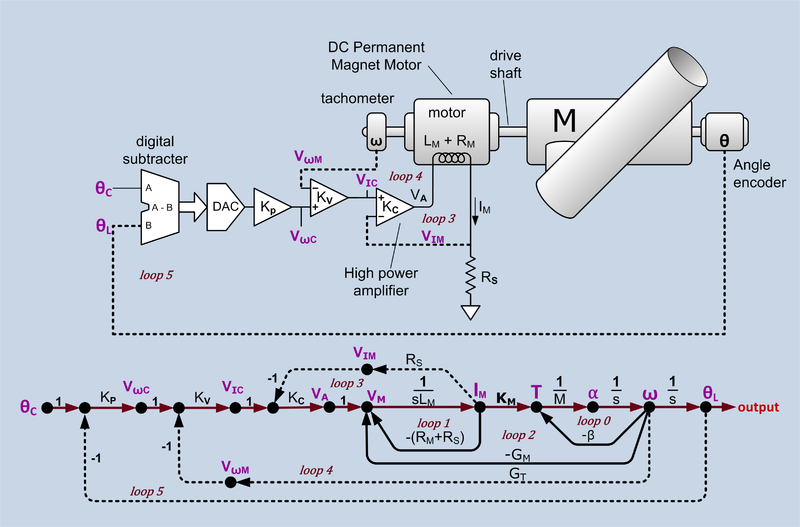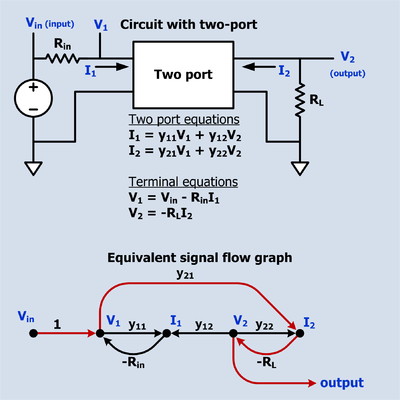- Mason's rule
-
Mason's gain formula (MGF) is a method for finding the transfer function of a linear signal-flow graph (SFG). The formula was derived by Samuel Jefferson Mason[1] and is named after its discoverer. MGF is an alternate method to finding the transfer function algebraically by labeling each signal, writing down the equation for how that signal depends on other signals, and then solving the multiple equations for the output signal in terms of the input signal. MGF provides a step by step method to obtain the transfer function from a SFG. Often, MGF can be determined by inspection of the SFG. The method can easily handle SFGs with many variables and loops including loops with inner loops. The method, being simple and mechanical and can often require less effort and is less error prone than the direct algebraic method. MGF comes up often in the context of control systems and digital filters because control systems and digital filters are often represented by SFGs.
Contents
Formula
The gain formula is as follows:
where:
- Δ = the determinant of the graph.
- yin = input-node variable
- yout = output-node variable
- G = complete gain between yin and yout
- N = total number of forward paths between yin and yout
- Gk = gain of the kth forward path between yin and yout
- Li = loop gain of each closed loop in the system
- LiLj = product of the loop gains of any two non-touching loops (no common nodes)
- LiLjLk = product of the loop gains of any three pairwise nontouching loops
- Δk = the cofactor value of Δ for the kth forward path, with the loops touching the kth forward path removed. I.e. Remove those parts of the graph which form the loop, while retaining the parts needed for the forward path.
Procedure
To use this technique,
- Make a list of all forward paths, and their gains, and label these Gk.
- Make a list of all the loops and their gains, and label these Li (for i loops). Make a list of all pairs of non-touching loops, and the products of their gains (LiLj). Make a list of all pairwise non-touching loops taken three at a time (LiLjLk), then four at a time, and so forth, until there are no more.
- Compute the determinant Δ and cofactors Δk.
- Apply the formula.
Examples
Circuit containing two-port
The transfer function from Vin to V2 is desired.
There is only one forward path:
-
- Vin to V1 to I2 to V2 with gain

- Vin to V1 to I2 to V2 with gain
There are three loops:
-
- V1 to I1 to V1 with gain

- V2 to I2 to V2 with gain

- V1 to I2 to V2 to I1 to V1 with gain

- V1 to I1 to V1 with gain
 note: L1 and L2 do not touch each other whereas L3 touches both of the other loops.
note: L1 and L2 do not touch each other whereas L3 touches both of the other loops.
 note: the forward path touches all the loops so all that is left is 1.
note: the forward path touches all the loops so all that is left is 1.
Digital IIR biquad filter
Digital filters are often diagramed as signal flow graphs.
- There are two loops
 Note, the two loops touch so there is no term for their product.
Note, the two loops touch so there is no term for their product.
- There are three forward paths
- All the forward paths touch all the loops so

Servo
 Angular position servo and signal flow graph. θC = desired angle command, θL = actual load angle, KP = position loop gain, VωC = velocity command, VωM = motor velocity sense voltage, KV = velocity loop gain, VIC = current command, VIM = current sense voltage, KC = current loop gain, VA = power amplifier output voltage, VM = effective voltage across the inductance, LM = motor inductance, IM = motor current, RM = motor resistance, RS = current sense resistance, KM = motor torque constant (Nm/amp) , T = torque, M = momment of inertia of all rotating components α = angular acceleration, ω = angular velocity, β = mechanical damping, GM = motor back EMF constant, GT = tachometer conversion gain constant,. There is one forward path (shown in a different color) and six feedback loops. The drive shaft assumed to be stiff enough to not treat as a spring. Constants are shown in black and variables in purple.
Angular position servo and signal flow graph. θC = desired angle command, θL = actual load angle, KP = position loop gain, VωC = velocity command, VωM = motor velocity sense voltage, KV = velocity loop gain, VIC = current command, VIM = current sense voltage, KC = current loop gain, VA = power amplifier output voltage, VM = effective voltage across the inductance, LM = motor inductance, IM = motor current, RM = motor resistance, RS = current sense resistance, KM = motor torque constant (Nm/amp) , T = torque, M = momment of inertia of all rotating components α = angular acceleration, ω = angular velocity, β = mechanical damping, GM = motor back EMF constant, GT = tachometer conversion gain constant,. There is one forward path (shown in a different color) and six feedback loops. The drive shaft assumed to be stiff enough to not treat as a spring. Constants are shown in black and variables in purple.
The signal flow graph has six loops. They are:
There is one forward path:
The forward path touches all the loops therefore the co-factor Δ0 = 1
And the gain from input to output is
Equivalent matrix form
Mason's rule can be stated in a simple matrix form. Assume
 is the transient matrix of the graph where
is the transient matrix of the graph where ![t_{nm} = \left[\mathbf{T}\right]_{nm}](0/d8075f4b9172c97ff9c65e4e6dca15ab.png) is the sum transmittance of branches from node m toward node n. Then, the gain from node m to node n of the graph is equal to
is the sum transmittance of branches from node m toward node n. Then, the gain from node m to node n of the graph is equal to ![u_{nm} = \left[\mathbf{U}\right]_{nm}](c/6ac3275c811d40d4cf251abf6a7d44da.png) , where
, where ,
,
and
 is the identity matrix.
is the identity matrix.Mason's Rule is also particularly useful for deriving the z-domain transfer function of discrete networks that have inner feedback loops embedded within outer feedback loops (nested loops). If the discrete network can be drawn as a signal flow graph, then the application of Mason's Rule will give that network's z-domain H(z) transfer function.
Notes
- ^ Mason, Samuel J. (July 1956). "Feedback Theory - Further Properties of Signal Flow Graphs". Proceedings of the IRE: 920–926.
References
- Bolton, W. Newnes (1998). Control Engineering Pocketbook. Oxford: Newnes.
- Van Valkenburg, M. E. (1974). Network Analysis (3rd ed.). Englewood Cliffs, NJ: Prentice-Hall.
Categories:
Wikimedia Foundation. 2010.




















